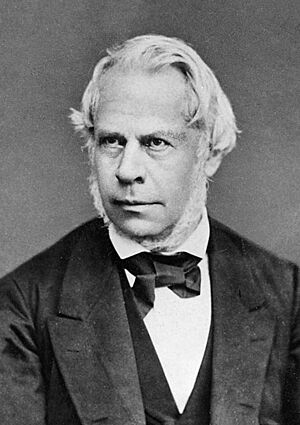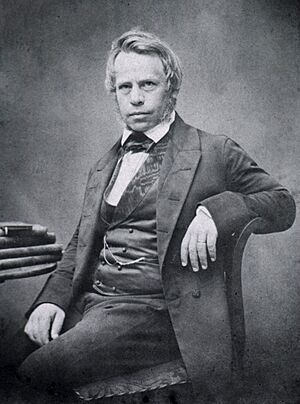Friedrich Gustav Jakob Henle facts for kids
Quick facts for kids
Friedrich Gustav Jakob Henle
|
|
|---|---|
 |
|
| Born | 9 July 1809 Fürth, Kingdom of Bavaria
|
| Died | 13 May 1885 (aged 75) |
| Alma mater | University of Heidelberg University of Bonn |
| Known for | Loop of Henle, Handbook of Systematic Human Anatomy |
| Scientific career | |
| Fields | Pathology, anatomy |
| Doctoral advisor | Johannes Peter Müller |
Friedrich Gustav Jakob Henle (born July 9, 1809 – died May 13, 1885) was a German doctor, a pathologist (someone who studies diseases), and an anatomist (someone who studies the body's structure). He is famous for discovering a part of the kidney called the loop of Henle. He also wrote an important essay that helped develop the idea that tiny germs cause diseases. He played a big role in shaping modern medicine.
Contents
Life and Work of Jakob Henle
Jakob Henle was born in Fürth, Bavaria. His parents were Simon and Rachel Diesbach Henle. He was Jewish.
Early Studies and Research
Henle studied medicine at the University of Heidelberg and the University of Bonn. He earned his doctor's degree in 1832. After that, he worked in Berlin with Johannes Peter Müller, a famous anatomist.
For six years, Henle did a lot of research. He wrote about new animal species. He also studied the lymphatic system (which helps fight infections), how epithelium (a type of body tissue) is spread in the human body, and how hair grows. He also researched how mucus and pus form. During this time, he became friends with Theodor Schwann, who later became famous for his cell theory.
Teaching and Major Books
In 1840, Henle became a professor of anatomy at the University of Zürich. In 1844, he moved to Heidelberg. There, he taught anatomy, physiology (how the body works), and pathology.
Around this time, he worked on a big project. He helped create a new edition of a book about general anatomy. He also wrote a book with Johannes Müller about sharks and rays.
In 1846, his important book, Manual of Rational Pathology, started to be published. This book changed how people studied diseases. Henle believed that physiology and pathology were connected. He looked at diseases by understanding how the body normally works.
Discoveries at Göttingen
In 1852, Henle moved to the University of Göttingen. Three years later, he began publishing his huge book, Handbook of Systematic Human Anatomy. The last part of this book came out in 1873. This book was one of the most complete anatomy books of its time. It was known for its detailed descriptions and excellent pictures. These pictures helped explain tiny parts of the body, like blood vessels, kidneys, and the eye.
It was in this book that he described the loop of Henle and Henle's tubules. These are two important structures found in the kidney.
Other Discoveries Named After Henle
Many other parts of the body or medical findings are named after Jakob Henle. Here are some of them:
- Crypts of Henle: Tiny pockets in the conjunctiva of the eye.
- Hassall–Henle bodies: Clear growths in the eye's Descemet's membrane.
- Henle's fissure: Fibrous tissue found between cardiac muscle fibers in the heart.
- Henle's ampulla: A part of the uterine tube.
- Henle's layer: The outer layer of cells in a hair follicle.
- Henle's ligament: A tendon in the abdomen.
- Henle's membrane: A layer in the eye's choroid.
- Henle's sheath: Connective tissue that supports nerve fibers.
- Henle's spine: A bone landmark near the ear.
- Glands of Henle: Depressions in the eye where certain cells collect.
- Tubes of Henle: Tiny tubes connecting parts of the eye.
Germ Theory Contributions
Henle also helped develop the idea that tiny living things, like bacteria, cause infectious diseases. He wrote about this in his essay "On Miasma and Contagia" in 1840. He built on ideas from earlier scientists.
He didn't discover a specific type of bacteria himself. But his student, Robert Koch, did. Together, Henle and Koch created important rules for identifying which microbes cause specific diseases. These rules are known as the Henle Koch postulates.
In 1870, Henle became a foreign member of the Royal Swedish Academy of Sciences. He passed away in Göttingen on May 13, 1885.
See also
 In Spanish: Friedrich Gustav Jakob Henle para niños
In Spanish: Friedrich Gustav Jakob Henle para niños
- Category:Taxa named by Friedrich Gustav Jakob Henle


